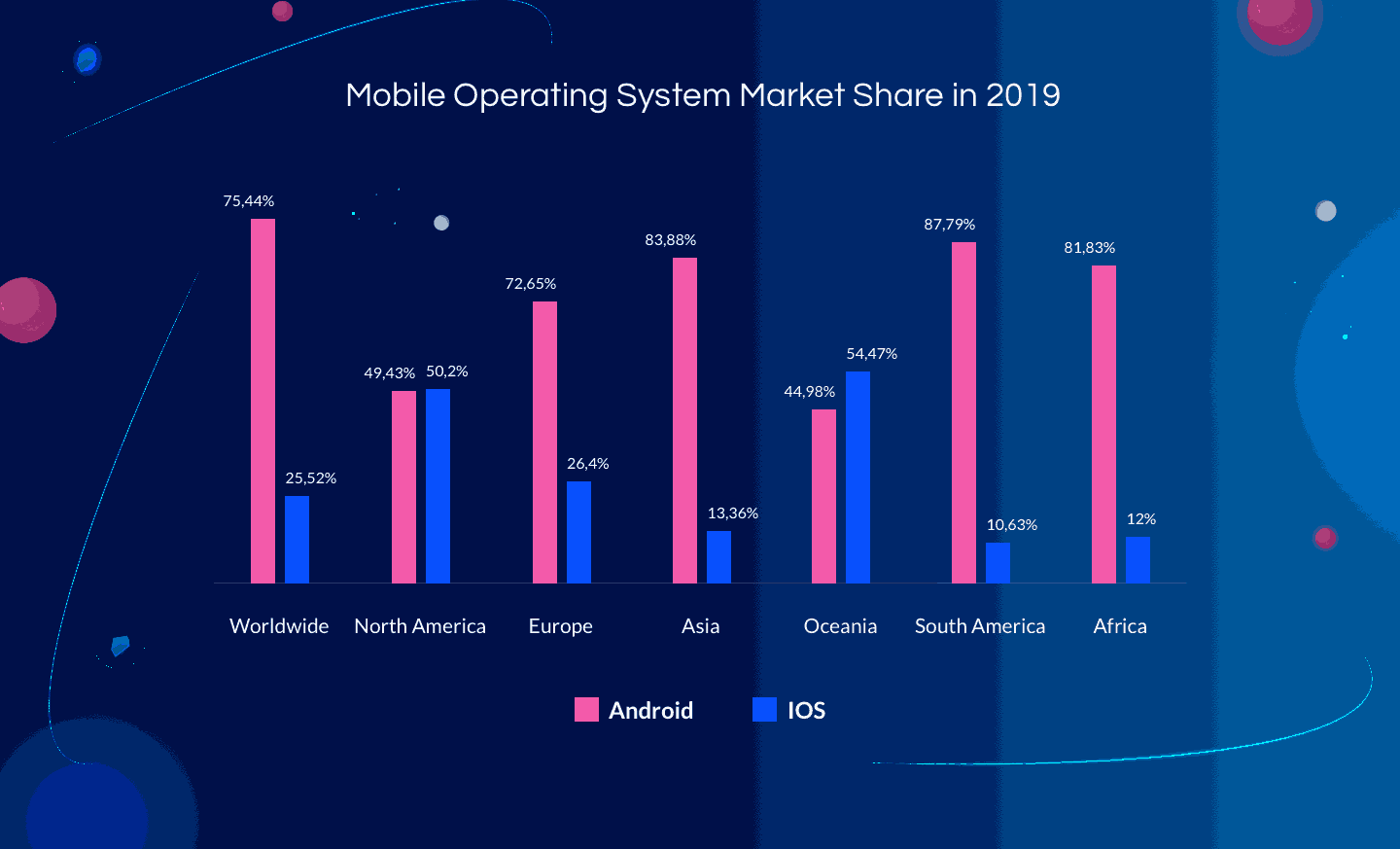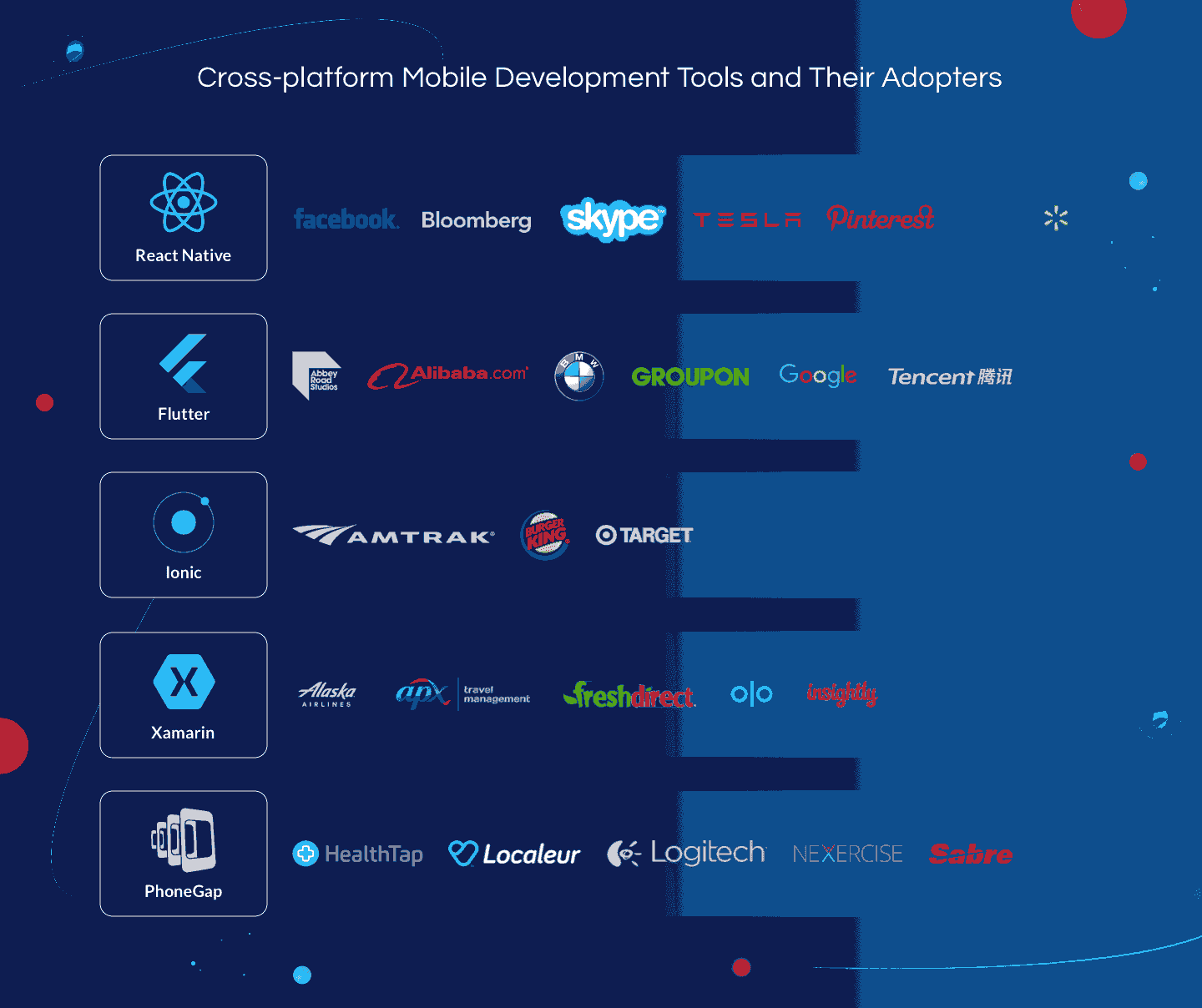Smartphone usage has skyrocketed, with the average person now spending over 3 hours daily on their devices—a noticeable rise driven largely by social media, gaming, and diverse mobile applications. To successfully tap into this booming mobile application market, creating an engaging software product that appeals to a wide audience is critical.
But beyond design and appeal, ensuring your app runs seamlessly across various mobile platforms and operating systems is equally essential. Selecting the right cross-platform mobile development tools can significantly simplify this task, speeding up development and helping you deliver a polished, high-performing app to users worldwide.
In this article, we explore globally popular mobile operating systems, weigh the advantages of native versus cross-platform app development, and provide a comprehensive overview of the best cross-platform mobile development frameworks and tools available in 2025.
Best Cross-Platform Mobile Development Tools & Frameworks
Numerous tools and frameworks exist for cross-platform app development, each offering unique strengths. We’ve conducted thorough market research and shortlisted the best options to consider:
- React Native
- Flutter
- Ionic
- Xamarin
- PhoneGap
- NativeScript
- Appcelerator Titanium
React Native
React Native, released by Facebook in 2015, is a widely used open-source framework based on React. Mark Zuckerberg initially criticized hybrid apps but later promoted React Native, seeing it as a major improvement. Apps built with React Native resemble native apps closely, enabling access to native device features like cameras and geolocation, all while using JavaScript. It boasts a robust global community, extensive documentation, and impressive performance. Companies like Facebook, Bloomberg, Skype, Tesla, Pinterest, and Walmart trust React Native for their mobile applications.
Flutter
Flutter is Google’s open-source framework introduced in 2017, designed for building native apps across platforms like Android and iOS using the Dart programming language. Known for its fast development cycles and customizable widgets, Flutter provides an efficient path to creating responsive, visually appealing interfaces. It includes pre-built widgets and libraries facilitating functionalities such as animations, maps, and network connectivity.
Google enhanced Flutter’s integration support with existing native apps in 2019. Notable companies using Flutter include Alibaba, BMW, Groupon, and Tencent.
Ionic
Ionic, initially released in 2013, enables the building of apps for iOS and Android from a single codebase. Known for its speed, performance, and ease of use, Ionic helps developers accelerate timelines without sacrificing quality.
It supports popular web technologies, including HTML, CSS, and JavaScript, making it accessible for web developers. Ionic offers extensive resources, clear documentation, and comprehensive tools to streamline app development.
Its active community allows developers to quickly find solutions and share best practices. Leading brands such as Amtrak, Burger King, and Target rely on Ionic for their cross-platform mobile apps.
Xamarin
Xamarin is a User Interface framework that you might consider when it comes to mobile app development. It’s an open-source tool powered by Microsoft since 2016. This app platform helps build apps that share a single codebase on Android, iOS, Windows, and other operating systems. Xamarin can run not only on mobile devices but also on the web and desktop. You can create apps for Windows Phone, Android, and iOS with the help of C#, which is the programming language supported by this cross-platform mobile development tool.
However, as of now, this tool is already a bit outdated. If you opt for this alternative, you might face several disadvantages. App overhead, the lack of community support, the high cost for professional use as well as stability issues might discourage you from using this tool. Thus, we recommend considering other options before making the final decision on the tech stack for your project.
The companies that actively use Xamarin in their projects are Alaska Airlines, Atlantic & Pacific Business Travel Limited, FreshDirect, OLO, Insightly, and others.
PhoneGap
PhoneGap is an open-source, cross-platform mobile development tool supported by Adobe. It is built on top of Apache Cordova, which provides a set of native APIs to access device features such as the camera, accelerometer, and contacts. PhoneGap extends Cordova by adding additional tools and services such as cloud building, app signing, and analytics.
With this cross-platform application framework, developers can create mobile apps using familiar web technologies, which can significantly reduce the learning curve and development time. PhoneGap’ applications can be packaged and distributed through app stores or deployed as web applications. It will come in handy if you do not need to utilize the native feature set of a mobile device. It encompasses JavaScript, HTML & CSS into a container that can access API.
HealthTap, Localeur, Logitech, Nexercise, and Sabre are among the companies that successfully utilize PhoneGap.
NativeScript
NativeScript is a popular open-source cross-platform app framework for building truly native mobile applications using JavaScript, TypeScript, Angular, or Vue.js. With NativeScript, developers can leverage their existing web development skills to create mobile apps that have the performance and user experience of native applications.
One of the key features of NativeScript is its ability to access native APIs directly from JavaScript, allowing developers to tap into the full power of the underlying platform. This enables the creation of highly customized and feature-rich applications that seamlessly integrate with the native capabilities of the device.
Another advantage of NativeScript is its support for a wide range of plugins and modules, which extend its functionality and enable developers to easily add new features to their apps. These plugins cover various aspects such as accessing device hardware, integrating with third-party services, and enhancing the user interface.
NativeScript also provides a rich set of UI components that are designed to look and feel native on each platform, ensuring that apps built with NativeScript have a consistent and polished appearance across different devices and operating systems.
Companies like Adidas, Johnson & Johnson, and Nintendo leverage NativeScript’s cross-platform capabilities for their mobile apps.
Appcelerator Titanium
Appcelerator Titanium allows developers to use JavaScript, HTML, CSS, and other web technologies to build applications for various platforms including iOS, Android, and Windows.
Appcelerator Titanium also provides a comprehensive set of APIs and modules that allow developers to access native device features such as GPS, camera, accelerometer, and more, enabling them to create highly functional and feature-rich applications.
Another advantage of Appcelerator Titanium is its support for rapid prototyping and iteration, allowing developers to quickly build and test their applications across multiple platforms without the need for separate codebases.
Appcelerator Titanium, while historically prominent, is not as widely used compared to modern choices like Flutter or React Native. However, several large companies like Honeywell and Home Depot still utilize it for its enterprise features and legacy code support.
The Most Widely Used Operating Systems
Operating systems are the software that runs on our devices and enables us to interact with them. They provide a platform for running applications, managing hardware resources, and executing system-level tasks. The choice of operating system can greatly influence the user experience and productivity. With the wide choice of them in the market, it is essential for businesses and developers to understand user demographics and preferences.
In this section, we will take a closer look at the most popular operating systems used worldwide. We will examine the user demographics, features, and benefits of each operating system. By understanding their strengths and weaknesses, businesses and developers can tailor their products and services to better meet the needs of their target audience.
If you want to build an app to engage a significant number of users, you need to understand what type of OS your target audience uses. According to Statсounter, a real-time web analytics service provider, iOS and Android for mobile devices are indeed the most popular operating systems for smartphones and tablets around the globe. As of February 2023, Android has a 72,58% market share worldwide, while iOS has 27,11%.
Below you can check the two most popular operating systems around the world — iOS and Android.

Statista, a company specializing in market data, will provide data on mobile operating system distribution for software development around the globe in 2025. You can clearly see that Android accounts for 71.88%, iOS — 27.6%, and approximately 2% for other OS mobile platforms.
Another piece of data from Statista shows the number of mobile apps present in the most popular app stores as of the first quarter of 2025:
- Google Play — 2.3 milion
- Apple Store — 2 milion
- Amazon Appstore — 526,000
Although 2022 has been a difficult year for almost every business sphere, it seems that it has not affected the mobile app market. The global application revenue reached more than $150 billion in the first part of 2024. Users have spent their money on various applications in the Google Play Store and Apple Store.
If you would like to have a strong influence on the mobile application market to the fullest, you should target both Android and iOS users. There are two reliable ways you can hit the mark — through native and cross-platform development tools.
Cross-Platform vs Native Development
Android is supported by Google, and it is an open-source OS, meaning that it can operate on various mobile phones manufactured by different companies, like Samsung, Huawei, LG, and others. iOS, for its part, is Apple’s proprietary operating system. Thus, it can be used only on the company’s devices — iPhones or iPads.
There are two popular types of mobile development — native and cross-platform, which are perfect for Android and iOS. Also, they have their advantages and disadvantages. Let’s consider them more closely.
Native development is the development of mobile apps that have a codebase that is created to run on a specific operating system — iOS or Android (or any other). For instance, Instagram, despite looking quite similar on both OSs, is represented by two native mobile apps with separate codebases. The applications were written separately to target the users of both operating systems.
Native development has its benefits and drawbacks.
Advantages:
- Native mobile apps are fast
- Maximum benefits and easy access to push notifications
- Ability to access a phone’s native features
With native development, you will reap some excellent benefits. You can have access to the feature set of a mobile phone, e.g., GPS, camera, speaker, and so on. Apart from that, you can easily make use of push notifications that provide mobile apps’ owners with an opportunity to make their users more productive. You can also have push notifications on your cross-platform applications, but their creation and maintenance will cost an arm and a leg.
Besides, native mobile apps are high-performing and fast. Despite all the benefits you get with native mobile apps, this type of development has a set of inefficiencies that we are going to underline further.
Disadvantages:
- Excessive spending on the budget
- Resource-consuming development
- Slow delivery and launch of apps
- Difficulty in support
iOS native apps can’t run on Android, and vice versa. That is why to make the most out of your product, you need to have two separate codebases. This means that you will spend a large budget as you need to hire two teams. It will be time-consuming to develop and deliver your mobile apps. Also, it will be quite a hassle to support them afterward,d as you will have to fix issues of two native apps instead of only one.
Cross-platform mobile development is another type of hybrid mobile app development that allows your product to run on multiple mobile operating systems. It is written in a single programming language. When the code for an app is ready, it goes through a middleware that translates it into the native APIs of iOS or Android.
Advantages:
- Fast development in a short period of time
- Cost-effectiveness
- Reusable code
- Perfect business opportunity to engage a large share of the mobile app market
This type of mobile native app development will help you not to miss a chance to win a large mobile market share with an app that suits all major operating systems. You will save your money as you need only one codebase to run your app on multiple OSs. By using cross-platform development, you have a lucrative opportunity to create an app that will be appealing to Android, iOS, and other OS users without spending a lot of money.
Disadvantages:
- Limited access to native features
- Issues with user experience
With cross-platform framework development, you will have limited opportunity to a phone’s feature set as all devices have different functionality. As a result, you might deal with some issues regarding user experience, because all devices have their own functionality and mobile platforms. Thus it makes a cross-platform mobile app less competitive compared to native apps.
If you do not want to risk user experience and want to use a phone’s native features to the fullest extent, you can go for the native hybrid mobile app development. Nevertheless, if startups want to launch an app to grasp a broad audience, but without spending tons of money and doing it in a short time, cross-platform mobile development will be the most preferred option for such companies.
You do not need to build a native application if you can create a cross-platform app and deploy it on any mobile operating system. To get a more precise understanding of what is better – native or cross-platform, read our recent article about hybrid mobile app development.

Selecting the Optimal Cross-Platform Mobile Development Tools
Cross-platform mobile development tools are becoming increasingly popular as they offer a convenient way to develop mobile applications that can run on multiple mobile platforms. With the rise of mobile devices, businesses are seeking to develop applications that cater to their target audience across various mobile operating systems such as iOS, Android, and Windows. However, developing separate apps for each platform can be a time-consuming and costly process.
Therefore, cross-platform development tools have emerged as a popular alternative to creating software that can run on multiple mobile platforms with minimal effort. These tools provide a single codebase that can be used to create applications for different mobile operating systems, saving time and resources.
However, with so many cross-platform mobile development tools available in the market, it can be challenging to choose the best one for your project. Factors such as ease of use, performance, cost, and compatibility must be taken into account while selecting the right tool.
There are a lot of cross-platform mobile app development tools to choose from, and the right choice depends on your needs, requirements, and concerns. Also, tools are continually changing and updating; that is why you have to keep an eye on them all the time to pick up the best option. Here is a short list of factors you should consider before choosing the right cross-platform mobile development tool:
- Reliability
It is always good to know what popular companies use for their apps. You can take Facebook as the benchmark.
- Budget
When budget plays an essential role in the development process of a mobile app, you can go for open-source, cross-platform mobile app development tools. For example, React Native and Ionic are one of them. It would be a wise choice as startups have a lot of things to spend their money on, for instance, paying salaries to employees or renting a modern office, so you should spend your budget wisely. You can also estimate your solution with our app development calculator and get a free quote right away.
- Support of Tools
Pay close attention to the support of cross-platform mobile development tools. If you encounter any issue while developing your app, you can address a community to solve the problem. For instance, React Native, Ionic, Flutter have large support communities of users, and there is readable documentation and websites to help developers with challenging projects. This means that you will be able to troubleshoot any problem.
Wrapping Up
There are quite a few operating systems out there. iOS and Android are definitely among the market leaders around the globe. In order not to sit on the fence for a long time, you’d better opt for cross-platform development. It has many advantages, like the speed of development, one codebase, cost-saving, and many others. You can choose from many cross-platform mobile app development tools: Flutter, React Native, Ionic, and others. Many tools are open sources, utilized by famous companies, and have a significant number of supporting communities. Equipped with such tools, you will definitely conquer a good piece of the mobile development market.
If you are looking to create a hit cross-platform mobile app but have no idea where to start, you can always get in touch with LITSLINK. Our professionals have profound knowledge and the right skills in cross-platform app development services to build an app that will run on multiple operating systems. React Native, Flutter, and Ionic are among those technologies that are used the most for the purpose. Moreover, LITSLINK was one of the first companies to adopt React Native, the most popular cross-platform mobile development tool developed by Facebook in 2015. You can also check our IT outsourcing case studies to see what we do for clients.




